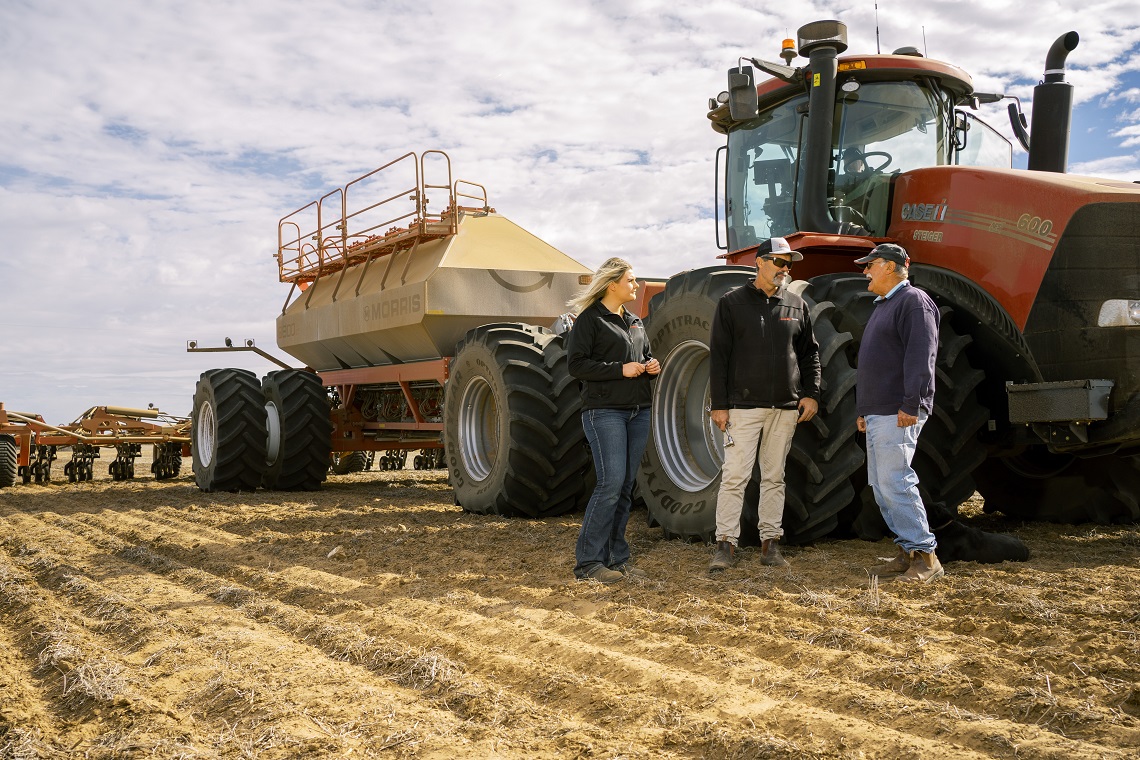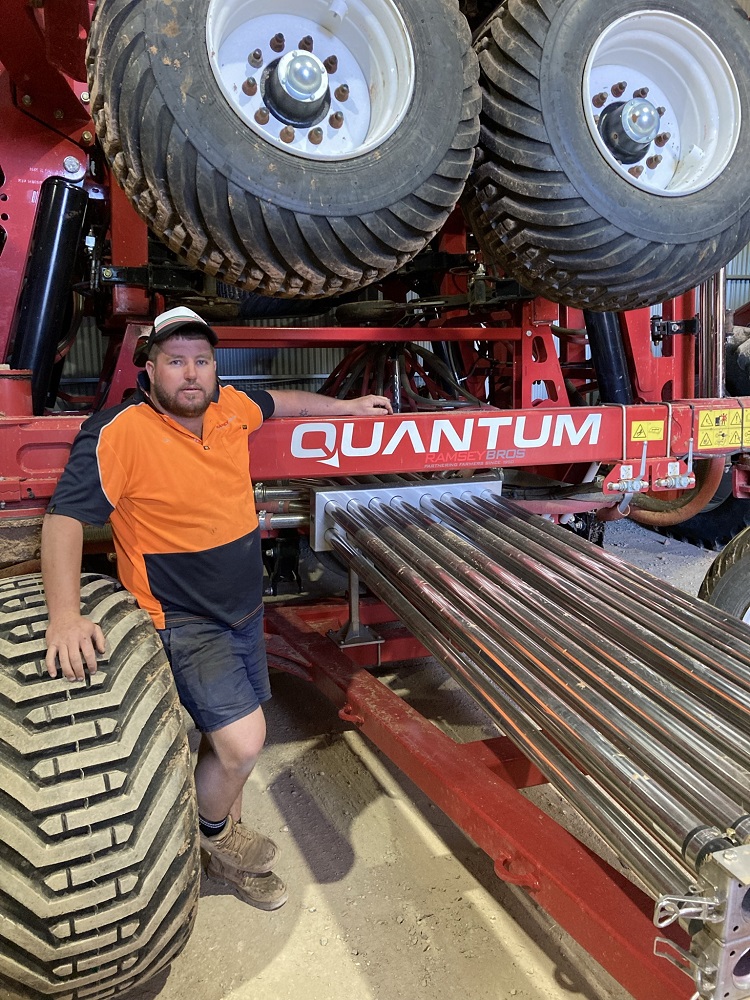

26 October 2021
THE old adage “bigger is better’’ has certainly rang true for the Michaels family near Wudinna on the Eyre Peninsula this season after they took a “quantum’’ leap with their main seeding rig.
Ashley Michaels and his fiancé Rachael, together with parents, John and Heather, crop just under 7000 hectares to wheat, barley, canola, lupins, lentils and field peas on their ‘Kerriemuir’ property, while they also run a self-replacing Merino flock comprising 1600 breeding ewes.
The sheep graze dune-swale soils through to rocky country and the remaining heavier red country and loams are continuously cropped, usually following a canola-wheat-barley-pulse rotation.
The Michaels have had a long association with Morris tillage and seeding equipment, graduating from a 9000 spring tyne bar to a C1 Contour Drill the past 12 years, hitched to a 12,000-litre Morris 8 Series air cart.
“The bar was getting tired and needed updating and we wanted to go a bit bigger with the ‘box’ to help increase productivity,’’ Ashley said.
“We were happy with the C1 though, so we wanted to stay with that principle of a good, ground following precision seeder for our good country.’’
They use a Case Concord machine over some of the more rugged country.
After viewing a machine demonstration by local Morris dealer, Ramsey Bros at Wudinna, and “having a play’’, as well as checking in with a neighbour who had a similar machine, the family opted for a 21-metre Morris Quantum air drill and 9800 Series air cart with Input Control Technology (ICT). The rig is pulled by a Case Steiger 600 and they also switched to a tow-between configuration with the air cart to effectively move more weight on to the tractor, thereby preventing bogging.
The Quantum air drill is set on 30-centimetre (12-inch) tyne spacings and uses a paired-row seeding boot to sow seed 75 millimetres apart, with fertiliser applied in between. The seed is sown at a depth of about 35-40mm and the fertiliser another 5mm below.
Ashley said the Morris Quantum was an enormous update on the C1 in terms of its frame design and the size of the tyres and related flotation was fantastic.
It uses unique, interlocking frame technology that has made it 154 per cent stronger than previous drills. Other features include improved shank spacing options; 3-metre controlled traffic capability with metric spacings and 5.4m transport width; 75pc less parts and 60pc less weldments; a stronger front and rear hitch design; and an active hydraulic system with ability to control Morris Auto-Lift and Auto-Pack control.
The heavy-duty hitch uses 20pc more steel than previous hitches and is connected to the frame with chrome pins that fit into hardened steel bushings.
“Ramsey (Bros) did a great job of putting it together – they look after us – and we also get good support from Nigel Hodge (McIntosh Distribution, national distributor for Morris),’’ Ashley said.
“It could go everywhere and I don’t think we would break it. We sowed 5000ha dry prior to the opening rains.’’
He said the new and continuous hydraulic flow was excellent for the rougher country and it was simple to operate.
“It just floats over the hills and the Auto-Lift and automatic end-of-row turning, linked to the Topcon X35 controller, makes it easy.’’
“It lifts itself, turns itself and goes back in the ground. All these features help it go into the right spot correctly, so you don’t leave wedges (of missed ground). It can help avoid operator problems and you can take comfort in knowing the machine is going in square to the runs.’’
Upright, stainless steel air kits also had made it a “nice and neat machine’’.
The Michaels’ air drill was one of several Quantum machines in the region fitted with the new air kits by Ramsey Bros technician Keron Cummings at Wudinna.
Keron said he had chalked-up about 15 years working on Morris equipment and this year received great support from Duncan Murdoch at McIntosh Distribution for the installation of the air kits.
“I worked with Duncan a lot. Instead of chatting and describing things over the phone, we were even face-timing each other,’’ Keron said.
“Depending on the sizes of machines and the tyne spacings, you can have more secondary outlets and need to take care with the placing of hoses through the folds. In some cases, we took photos to see where the hoses needed to run and everything worked very well.
“It was certainly a lot easier to do than flat fan heads.’’
Ashley said ‘Kerriemuir’ was shaping up for one of its better cropping seasons, but the Quantum air drill and its sowing accuracy had contributed to better crop germinations in rocky country, as well as on the lighter soils.
“It wasn’t jumping out of the ground like the other machines. It just entered softer and more seed was getting planted. It also did a good job over the sand, with the pressure backed-off so it was not bulldozing it in.’’
He said the four-bin air cart, carrying seed as well as DAP and urea fertilisers, had a capacity of more than 28,000L.
“The bigger box has practically doubled the area we cover and it has better segregation, so we run out of everything evenly. Previously, we might have done 55-65ha from a fill and that’s now 110-130ha.’’
Ashley said the ICT had matched savings achieved from auto-boom switching when spraying, amounting to around 5pc, however he anticipated that would rise a little more once they recreated the boundaries on their paddock maps.
Morris hydraulic drive air carts with ICT have shown to be the most accurate and reliable for section control over the past six years.
Ashley described Morris “section aware’’ integrated blockage monitoring with the seeding system, eliminating nuisance alarms when product is shut-off due to the ICT, as “awesome’’.
“I love it. With the older type heads, you could just get lumps of fertiliser, particularly with wet weather, and you had to check the heads twice per box-full. Now we just check it at the end of the box-full or at the midpoint.’’
“It’s our third Morris box and it’s been the next step-up in productivity – and it’s easy to calibrate now with smartphone technology.
“Our next step is looking towards variable rate (applications) now that we have a better system. We have already got a couple of years of data,’’ he said.
